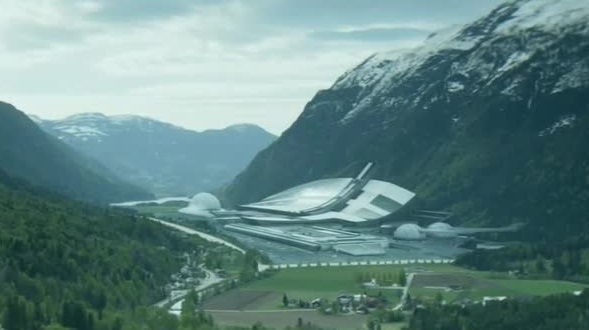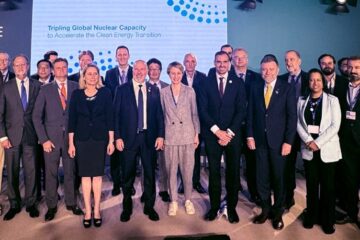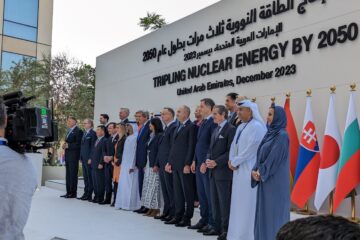It’s not about being “advanced”, it is ongoing innovation that will keep nuclear strong
This month in the United States, the Nuclear Energy Innovation Capabilities Act was passed to support federal research and development and stimulate private investment in advanced nuclear reactor technologies. All this good news about investment in the future made me think about how we use the words advanced and innovation in the nuclear industry. We first wrote about innovation in the nuclear sector two years ago. And what we said then still applies, in fact even more so, today.
When thinking about innovation in the nuclear industry, the discussion often centres around future reactor designs. However, this far too narrow focus tends to an argument that a so called advanced design is what is required to save the industry and implies that today’s designs are just not good enough. When we have a technology that produces abundant economic and reliable electricity with very low carbon, all while being one of the safest on earth; what we have today is something worth celebrating. Yet it is not unusual for some supporters of nuclear power to use the idea that new advanced designs are the magic sauce that will make nuclear great again.
Futuristic Thorium Plant from the Norwegian series “Occupied”
I was recently at a meeting where it was noted by someone who had recently visited Havana Cuba, that without access to newer technology, cars in Cuba are stuck in the past. The Cubans have found ways to keep these old cars running well past their original lives as they had no access to anything newer. And while we may find these relics fun to look at, we certainly don’t expect to be driving cars of this vintage. In fact, we know that while the cars of today basically look the same and operate in a similar manner to those of the 1950s, there is likely not one part that is the same as was made 50 years ago. Today’s car is made up of different materials, is computer controlled, is way more efficient and much much safer. This is all due to years and years of innovation. The same applies to nuclear plants. What would have happened if back in 1955 or so people only talked about and invested in what would replace cars for individual transport (i.e. “advanced” cars meaning electric vehicles or even flying cars) instead of how to make them better? The thought of it is just ridiculous. Yet that seems to be a common view of nuclear – that all we are doing is keeping old outdated plants (like 1950’s cars) operating until we get these shiny new plants of the future ready for deployment. Nothing can be further from the truth.
While yes, it is important to research and develop new concepts based on specific needs, for example closing the fuel cycle or using new types of fuel such as thorium; it is not the case that this is what is required to continue to evolve safety, reliability and economics. For that we must continue to focus our efforts on improving what we have – innovating, taking the reactor designs available today – and making them better. Just like cars, there is abundant technology in any given nuclear plant that extends far beyond what kind of fuel we choose to burn. Implementing changes means using a large spectrum of new technologies that are being constantly developed as is necessary in every industry that wants to keep moving forward.
A great current example is the commitment in the US through the “Delivering the Nuclear Promise: Advancing Safety, Reliability and Economic Performance” initiative as the way forward to address falling prices of alternative generation options. As stated, this “three-year program will identify efficiency measures and adopt best practices and technology solutions to improve operations, reduce generation cost and prevent premature reactor closure.” Now this is what drives innovation.
Extending the lives of current reactors through better understanding of how materials age, first to 60 years and next possibly to 80 years, use of remote tooling to reduce dose and shorten outages, use of new technology in controls to improve reliability; all of these things require innovation.
When it comes to new build, there is innovation in methods to reduce construction time and improve quality such as computer engineering tools, modularization and even simple things such as moving platforms to replace scaffolding and on and on and on. This is innovation. And let’s not forget about commercial innovation. Innovative business models such as those used in Canada for refurbishment and in the UK for new build are critical to future industry success. This even includes models from places like Russia where they are working with foreign customers in ways thought not possible in the past. Will this all work? Some things will and some things wont, but this is innovation. It is messy, it takes time – and it continues to move the industry forward. And most of this innovation will apply to all reactor types, todays and those of the future.
I support the development of future designs– just not at the expense of making the public think our current designs have hit their ‘best before date’. I am concerned that the industry is risking too much on the importance of government money for advanced designs– i.e. here is a few hundred million dollars to study designs for the 2030s so shut up and focus on the future – then come back in 20 years or so when you have the next great thing. We cannot afford a mindset that says nuclear must stop until then as the world continues to build more and more gas plants and renewables. Every year these alternatives, wind and solar get better – and we need to do the same (and frankly we are).
The world needs abundant low carbon, economic and reliable electricity now if we are to replace coal and meet the needs of an energy hungry world. To meet the WNA target of 1,000 GW – 1000 new, 1000 MW nuclear plants by 2050 means we need to be building lots of new plants TODAY – not waiting until the next big thing comes around in a decade or two.
So, today’s nuclear technology must continue to move forward and demonstrate it is a technology of the future and that improvements are continuing to come that make every project better than the last. We need to better celebrate our achievements and we need to continue to invest in further innovation because there is no choice but to continue to get better.
Our strength is through our performance. And our performance continues to get better through innovation, each and every day.






4 Comments
Sharon · March 20, 2016 at 7:51 pm
Oh so right on!!! Yes the nuclear industry has to step up to the plate but think they are at least on first base maybe second base — but positively working towards third. Carry on!!!!
François · March 21, 2016 at 7:01 am
Hi. So True, and this is sometimes the misconception behind the nuclear 2.0 as is advocated by motivated, open minded, very pragmatic and looking for humanity well being new nuclear advocates. Even Pandora promise is about this. We know too well that it is economy that is driving innovation.
The major breakthrough since the 50ies is in computing capabilities and data mining. This one not yet used to the most of its promises.
One concern is that advanced plants are safer safest… Is that possible? To take your example, Volvo is for example trying to market cars after 2020 with the promise that no one will ever die in a crash involving a volvo! That is ridiculous!! Although I would like to believe it. And all innovation and improvements will be much welcomed, in protection occupants. In protecting cyclists and pedestrians, in having a car that would take control whenever the driver makes mistake, or has not seen danger ahead!
Same with most advanced NPP s in the future…
On the other hand, our radio protection paradigms for the general population are to be reviewed if “next” time an accident occurs, we have to think about some sort of temporary evacuation.
Lets improve the current plants, with some kind of British ALARP principle. Let’s work on public understanding and faith in science and hard facts. Let’s have the medics and media understand the real dangers. Innovation is needed here. But not any human made technology will ever be 100% safe, fool proof, or “black Swan” event ready!
Thanks for your blog Milton. Always very mindful !! Francois
Mara · March 21, 2016 at 2:36 pm
So interesting, all for innovation!!!
African Rover · March 22, 2016 at 4:37 am
Innovation is great and is the logical development and improvement of an idea. But occasionally we might consider a fundamentally different approach. E.g. like we did when we stopped using the piston engine in larger aircraft and replaced them with jets.
So I feel strongly that we must probe alternative reactor technologies, they will do away with some of the problems we have with present designs, and no doubt will in due course give us problems of their own to solve. Right now the market is artificially limited by regulation. Somebody picked a winner in the1950ies and since then we are basically limited to 3 designs. Over regulation has made the nuclear technology in use unnecessarily expensive.
Comments are closed.